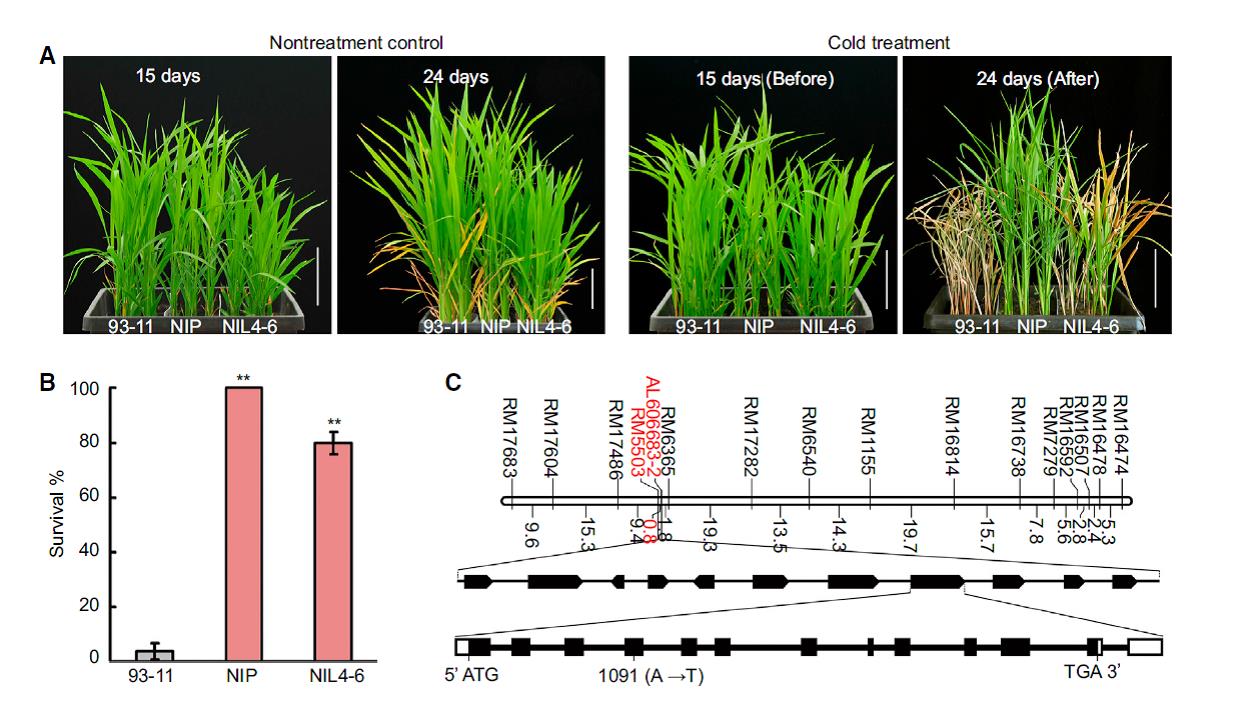Cell:粳稻缘何比灿稻更耐寒?
发布人: 发布日期: 2015年03月04日 00:00 浏览次数:
2015年3月2日讯 /生物谷BIOON/ --近日,来自中国科学院的研究人员在国际著名生物学期刊cell发表了他们的一项最新研究成果,他们发现cold1基因对于粳稻(japonica水 稻)的耐寒习性非常重要,cold1编码产物能够调控G蛋白信号通路,激活钙离子通道感受低温,同时他们还发现cold1的一个SNP位点对于其赋予粳稻 抗寒特性非常重要。
水稻喜高温、多湿、短日照,对低温敏感,低温使枝梗和颖花分化延长,开花最适温30℃左右,低于20℃或高于40℃,受精受严重影响。因此只能 种植在特定气候区域。japonica水稻(粳稻)是一种种植于温带和寒带地区的水稻品种,生长期长,一般一年只能成熟一次,粳稻具有耐寒习性,粒形短 圆,与野生稻有较大差异。人类对粳稻施加的人工选择使得水稻能够生长在温度更低的区域,但这种低温适应性的分子基础仍不清楚。
研究人员发现cold1基因能够赋予粳稻耐寒特性,过表达cold1能够显著增强水稻耐寒抗冻的能力,但缺失或低表达cold1则使得水稻对低 温敏感。Cold1基因能够编码一种G蛋白信号通路的调控因子,调节定位在细胞质膜和内质网上的G蛋白复合物。其编码产物能够与G蛋白α亚基相互作用激活 钙离子通道,感受低温并加速G蛋白GTP酶活性。研究人员进一步鉴定出COLD1基因上来自于中国普通野生稻的一个SNP位点,增强了cold1赋予粳稻 耐寒特性的能力,这对于cold1在植物环境适应性方面发挥的作用非常重要。
综上所述,该项研究发现了粳稻耐寒习性的分子基础,通过实验证明了cold1通过调节G蛋白受体通路增强粳稻耐寒能力,并且发现了影响cold1功能的一个重要SNP位点。这项研究为植物抗寒特性研究提供了重要线索。

doi:10.1016/j.cell.2015.01.046
COLD1 Confers Chilling Tolerance in Rice
Yun Ma1, 7, Xiaoyan Dai1, 7, Yunyuan Xu1, 7, Wei Luo1, 7, Xiaoming Zheng2, Dali Zeng3, Yajun Pan4, Xiaoli Lin1, Huanhuan Liu1, Dajian Zhang1, Jun Xiao1, Xiaoyu Guo1, Shujuan Xu1, Yuda Niu1, Jingbo Jin1, Hui Zhang1, Xun Xu5, Legong Li4, Wen Wang5, Qian Qian3, Song Ge2, Kang Chong1
Rice is sensitive to cold and can be grown only in certain climate zones. Human selection of japonica rice has extended its growth zone to regions with lower temperature, while the molecular basis of this adaptation remains unknown. Here, we identify the quantitative trait locus COLD1 that confers chilling tolerance in japonica rice. Overexpression of COLD1jap significantly enhances chilling tolerance, whereas rice lines with deficiency or downregulation of COLD1jap are sensitive to cold. COLD1 encodes a regulator of G-protein signaling that localizes on plasma membrane and endoplasmic reticulum (ER). It interacts with the G-protein α subunit to activate the Ca2+ channel for sensing low temperature and to accelerate G-protein GTPase activity. We further identify that a SNP in COLD1, SNP2, originated from Chinese Oryza rufipogon, is responsible for the ability of COLDjap/ind to confer chilling tolerance, supporting the importance of COLD1 in plant adaptation.
